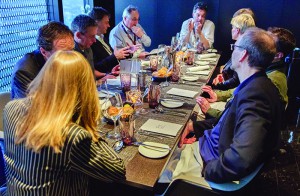 Audience: the key element behind all style and content decisions in any spoken or written material. When publications existed only in print, audience-related criteria were easier to maintain than they are these days. Bound periodicals lived in libraries sequestered by subject. Unless you knew where “your” material lived, you were unlikely to stumble upon it — but information could get lost. Manual crossreferencing wasn’t easy, and I would not want to return to the days before powerful Internet search engines! But now, readers often are directed to materials for which they themselves are not the primary audience.
Audience: the key element behind all style and content decisions in any spoken or written material. When publications existed only in print, audience-related criteria were easier to maintain than they are these days. Bound periodicals lived in libraries sequestered by subject. Unless you knew where “your” material lived, you were unlikely to stumble upon it — but information could get lost. Manual crossreferencing wasn’t easy, and I would not want to return to the days before powerful Internet search engines! But now, readers often are directed to materials for which they themselves are not the primary audience.
Audience considerations can drive editors nuts: Will academic readers be upset by the promotional appearance of trademark symbols? Will supplier authors be upset when we (by policy) leave registration marks out? Will engineers recognize the meanings of acronyms from microbiologists? Will the passive voice favored in laboratory notebooks be appropriate for readers from different disciplines?
 The need to learn everything we can about our audience is a major incentive for us to attend industry events covering a range of subject matter. We attend single-use conferences, advanced-therapy events, and supplier-organized seminars; sit in on business-focused plenaries and highly technical presentations; sample the smorgasbord of tracks at large multitopic events and tour supplier and end-user facilities, large and small. All this is so we can incorporate how people work, what equipment they use, and what they hope for the future into our editorial plans from month to month and year to year.
The need to learn everything we can about our audience is a major incentive for us to attend industry events covering a range of subject matter. We attend single-use conferences, advanced-therapy events, and supplier-organized seminars; sit in on business-focused plenaries and highly technical presentations; sample the smorgasbord of tracks at large multitopic events and tour supplier and end-user facilities, large and small. All this is so we can incorporate how people work, what equipment they use, and what they hope for the future into our editorial plans from month to month and year to year.
 One special event gave BPI publisher Brian Caine, associate publisher Chris Johnson, and me the opportunity to network with a diverse audience of key industry players at the April BPI European Summit in Vienna, Austria. High above the city, with sweeping views of the Danube and surrounding countryside, we enjoyed lively conversations at a VIP dinner hosting about 30 presenters and advisors — some thought leaders we’ve worked with for years along with enthusiastic newcomers to our segment(s) of the industry.
One special event gave BPI publisher Brian Caine, associate publisher Chris Johnson, and me the opportunity to network with a diverse audience of key industry players at the April BPI European Summit in Vienna, Austria. High above the city, with sweeping views of the Danube and surrounding countryside, we enjoyed lively conversations at a VIP dinner hosting about 30 presenters and advisors — some thought leaders we’ve worked with for years along with enthusiastic newcomers to our segment(s) of the industry.
I learn as much from such conversations about what people do not know as what they do. So many are new to a position, learning different regulatory directions and how to place their new roles into context. This reinforces what I often tell authors and reviewers: We serve an audience of both knowledgeable readers and those who are new to the subject matter.
That underscores the importance of sharing expertise, asking questions, seeking out resources, and simply establishing a comfortable basis of communication. We are grateful to our Informa colleagues for recognizing the value of these relationships and organizing an event that gave us much food for thought and ideas for topics to pursue. There are many vehicles these days for sharing information and formats that offer something for everyone — and multigenerational perspectives about which vehicles are most preferred. Frequent communication with our authors, advisors, advertisers, and readers helps us best serve the informational needs of them all.
